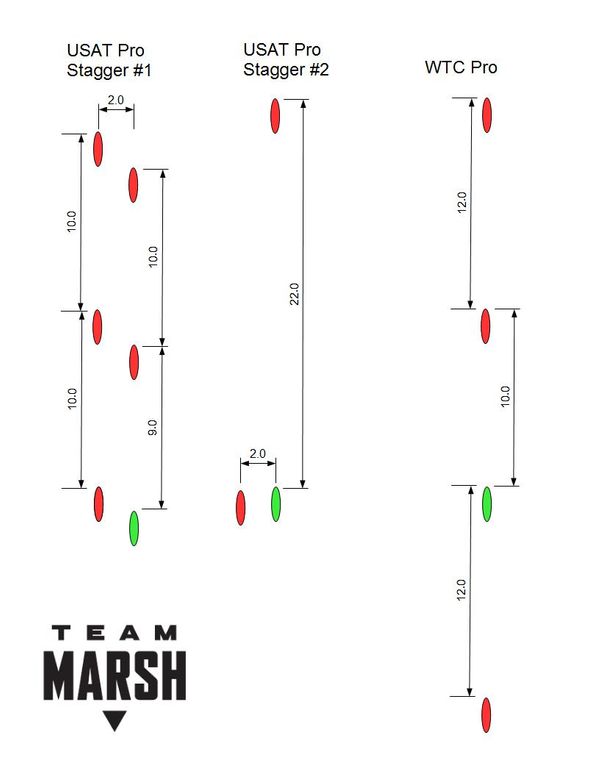Most rules operate under a set number of meters or bike lengths between riders. 1 bike length is approximately, or assumed to be about, 2 meters. Draft zones are measured from the front wheel. So, a draft zone of 2 meters by 10 meters extends roughly 1 meter to each side of the rider and 10 meters behind the riders front wheel. In bike length measurements that works out to ½ bike length to each side of the rider and 4 bike lengths BETWEEN riders, though USAT usually says 3 bike lengths.
USAT Stagger#1: There are six riders crammed into a box that is roughly 4 meters wide by 22 meters long. The USAT stagger rule states that the draft zone is a box 2 meters by 10 meters. And, you cannot ride directly behind the rider immediately in front of you. Draft zones must not overlap. So, in the graphic presented there is only 1 rider (green) who is in violation of position/drafting rules. He is in violation because he is 9 meters behind the 2nd rider in front of him. As opposed to the 2nd and 3rd graphics, an official must watch two lines of riders here to ensure that they are a) staggered off of the rider directly in front of them, b) maintaining sufficient space off of the 2nd rider in front of them, and c) executing a pass within 15 seconds. That's a lot to keep track of, and stay out of harms way. Now, add to that a quartering cross wind from the left of the picture, and you get a really nice draft if you're sitting on the right hand side of the line. Fair? Sorry, those last couple of sentences were a bit of personal bias, not really sorry.
USAT Stagger#2: This is probably the reasoning used when athletes or officials say that it is very easy to tell when someone is in violation. Regardless of the distance, a rider must be staggered off of the rider immediately in front of them. Once again, our green rider is in violation of the stagger rule even though he is over 2x the required distance behind the rider in front of him. The rider to his left, however, is legal because he is outside of the 2m draft zone and since side by side riding is allowed. This is straightforward and 'easy' as long as you are only dealing with 2 or 3 riders. Once you increase the number of riders, as in the case above, things get more confusing.
PS: If any one of the riders above moves to the left or right, then every rider behind them must shift to ensure that they maintain their stagger off the rider immediately in front of them. So, in a group of 6 riders as shown, if rider 1 decides to use the other side of the lane and moves, EVERYONE else must move as well.
WTC Rules: This is a graphic of a typical WTC (or non-draft ITU) race. The draft zone is a straightforward 12 meter zone. That means there must be at least 5 bike lengths between riders. Or, WTC commonly uses the dotted lines on US highways as markers as one line plus the space between lines is about 33 feet (10 meters) apart. There is one rider in violation, and again, that is the green rider. It's simple and easy. Ride right, pass left (unless in OZ, UK, certain parts of Asia). If you want to pass a rider, there must be sufficient space to slot in between 2 riders or you must pass the whole line. You have 25 seconds to execute each pass.
PPS. One of the arguments used in favor of the stagger rule is that it gives you more options when on a rough road, etc. In all of my years of racing, I've not felt like the officials were pushing me to ride to the extreme right hand side of a lane if the road conditions were poor. As long as an effort was made to ride right and pass left, that was the main thing.

